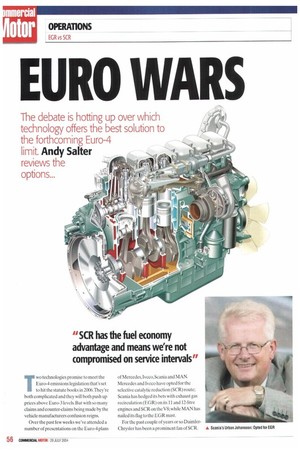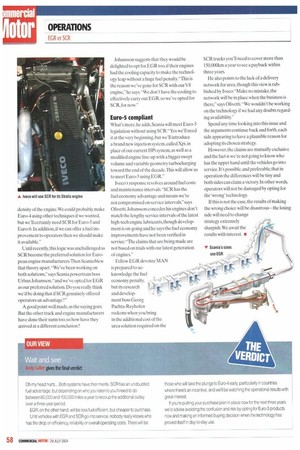EURO WARS
Page 56

Page 57

Page 58

If you've noticed an error in this article please click here to report it so we can fix it.
The debate is hotting up over which technology offers the best solution to the forthcoming Euro-4
limit. Andy Salter
reviews the options...
Two technologies promise to meet the Euro-4 emissions legislation that's set to hit the statute books in 2006.They're both coin plicated and they will both push up prices above Euro-3 levels. But with so many claims and counter-claims being made by the vehicle manufacturers confusion reigns.
Over the past few weeks we've attended a number of presentations on the Euro-4 plans of Mercedes. I veco,Scania and MAN. Mercedes and Iveco have opted for the selective catalytic reduction (SCR) route; Scania has hedged its bets with exhaust gas recirculation (EGR) on its 11 and 12-litre engines and SCR on the V8; while MAN has nailed its flag to the EGR mast.
For the past couple of years or so DaimlerChrysler has been a prominent fan of SCR. Now, as the deadline looms and countries around Europe begin to finalise their incentive schemes, the rest of the pack are making their positions known.
A lot of companies will go public with their strategies at the IAA Truck Show at Hanover in September; hence the flurry of press activity ahead of the show.
How the systems work
We've described the technology in detail over the past couple of months, but to recap, SCR uses a catalytic device in place of the silencer to break down NOx emissions from the engine.This requires a urea mixture, such as AdBlue. to he injected into the exhaust gases to make it work.This liquid in turn requires a storage tank on the truck and a supply infrastructure.
The plus point of SCR is that by treating the emissions outside the engine the combustion process can be optimised for efficiency.
As mentioned, Iveco is in the SCR camp for its truck enginesit will use EGR for the Daily van range and has been working on the technology for some time."Back in 1991. we began development work on SCR as part of a collaboration with Siemens. MAN and DaimlerChrysler," says Iveco engine product development chief Gianmaria Olivetti. "Even at this early stage it was clear the potential was there for development.
"The fuel efficiency is good and it gives us the freedom to further increase the power 110. density of the engine. We could probably make Euro-4 using other techniques if we wanted, but well certainly need SCR for Euro-5 and Euro-6. In addition, if we can offer a fuel improvement to operators then we should make it available."
Until recently. this logic was unchallenged as SCR become the preferred solution for European engine manufacturers.Then Scania blew that theory apart."We've been working on both solutions," says Scania powertrain boss Urban Johansson,"and we've opted for EGR as our preferred solution. Do you really think we'd be doing that if SCR genuinely offered operators an advantage?"
A good point well made, as the saying goes. But the other truck and engine manufacturers have done their sums too, so how have they arrived at a different conclusion? Johansson suggests that they would be delighted to opt for FOR too, if their engines had the cooling capacity to make the technology leap without a huge fuel penalty. "This is the reason we've gone for SCR with our V8 engine," he says. "We don't have the cooling to effectively carry out EGR, so we've opted for SCR. for now.
Euro-5 compliant
What's more, he adds, Scania will meet Euro-5 legislation without using SCR: "Yes we'll need it at the very beginning, but we'll introduce a brand new injection system, called Xpi, in place of our current HPi system, as well as a modified engine line-up with a bigger swept volume and variable geometry turbocharging toward the end of the decade.This will allow us to meet Euro-5 using EGR."
Iveco's response revolves around fuel costs and maintenance intervals. -SCR has the fuel economy advantage and means we're not compromised on service intervals," says Olivetti. Johansson concedes his engines don't match the lengthy service intervals of the latest high-tech engine lubricants, though development is on-going and he says the fuel economy improvements have not been verified in service:"The claims that are being made are not based on trials with our latest generation of engines."
Fellow FOR devotee MAN is prepared to ac knowledge the fuel tie't economy penalty, but its research and development boss Georg Pachta-Reyhofen reckons when you bring in the additional cost of the
)
urea solution required on the SCR trucks you'll need to cover more than 150,000km a year to see a payback within three years.
He also points to the lack of a delivery network for urea, though this view is rubbished by Iveco:"Make no rnistake.the network will be in place when the business is there," says Olivetti. "We wouldn't be working on the technology if we had any doubts regarding availability.
Spend any time looking into this issue and the arguments continue back and forth.each side appearing to have a plausible reason for adopting its chosen strategy.
However, the claims are mutually exclusive and the fact is we're not going to know who has the upper hand until the vehicles go into service. It's possible, and preferable, that in operation the differences will be tiny and both sides can claim a victory. In other words, operators will not be damaged by opting for the 'wrong' technology.
If this is not the case, the results of making the wrong choice will be disastrous — the losing side will need to change strategy extremely sharpish.We await the results with interest. •


















































































































































































